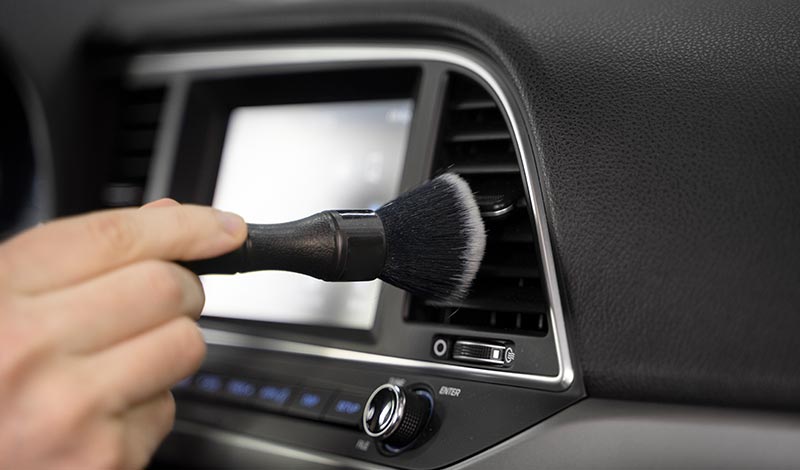Imagine stepping into your car on a sweltering summer day or a frosty winter morning and being greeted with the perfect burst of fresh air. This delightful experience hinges on the health of your car’s air conditioning system. Keeping this system in prime condition not only ensures comfort but is also integral to your health and the longevity of your vehicle.
Air conditioning in cars is no longer a luxury; it’s a necessity that impacts the overall driving experience. When functioning optimally, it provides a sanctuary from extreme weather conditions, ensuring a pleasant and safe journey. However, a neglected air conditioning system can lead to an array of issues, from unpleasant odours and poor air quality to reduced efficiency and eventual system failure.
Maintaining your car’s air conditioning is not just about comfort; it’s about creating a healthy in-car environment. The air you breathe inside your vehicle can be laden with pollutants, allergens, and bacteria if the system is not properly maintained. A fresh and efficiently running air conditioning system filters out these harmful particles, safeguarding your health.
In this guide, we’ll delve into the essential steps to keep your car’s air conditioning fresh and efficient year-round. From understanding the basics to regular maintenance and troubleshooting, we’ll equip you with the knowledge to ensure your journeys are always accompanied by the comfort of clean, fresh air.
Understanding the Basics of Car Air Conditioning
Car air conditioning, a crucial system in vehicles, primarily functions to cool the cabin, providing comfort and reducing driver fatigue. At its core, the system operates through a closed-loop mechanism involving several key components. Firstly, the compressor, powered by the car’s engine, compresses the refrigerant, which is the lifeblood of the system. This process elevates the refrigerant’s temperature and pressure, preparing it for the next stage.
The compressed, hot refrigerant then flows to the condenser, typically located at the front of the car near the radiator. Here, the refrigerant, aided by air flowing through the condenser when the car moves, dissipates its heat to the outside atmosphere, transforming from a gas to a liquid state.
Next, the now-cooled liquid refrigerant travels to the evaporator inside the car’s cabin. In the evaporator, the refrigerant absorbs heat from the cabin air and evaporates, effectively reducing the air temperature. A fan then circulates this cooled air into the cabin, providing a comfortable environment.
Finally, the refrigerant, having absorbed cabin heat and turned into a gas again, returns to the compressor, and the cycle repeats. This continuous process ensures a consistent supply of cool air, maintaining a pleasant temperature inside the car.
Regular Maintenance Tips
Regular maintenance is crucial for keeping your car’s air conditioning (AC) system efficient and fresh throughout the year. It’s recommended to schedule professional check-ups annually. Mechanics inspect key components like the compressor, condenser, and evaporator for proper functioning during these inspections.
Vital to this maintenance is the monitoring and refilling of the refrigerant, an essential fluid for cooling. Low refrigerant levels can significantly reduce system efficiency or cause damage. Thus, professional checks and refills are advised.
Replacing the air filter regularly is equally important. A clean filter promotes good air quality and efficient operation of the system. Typically, filters should be changed every 12,000 to 15,000 miles, though more frequent changes may be necessary in dusty environments.
Monitoring the AC’s performance is essential. Reduced airflow, strange noises, or insufficient cooling are indicators of potential problems. Addressing these issues promptly can prevent extensive, costly repairs.
Additionally, regularly checking for leaks and blockages can extend the system’s lifespan and improve performance. This maintenance not only ensures comfort but also enhances the air quality inside your car.
Practising these maintenance steps regularly is key to ensuring that your car’s AC system remains fresh, efficient, and reliable, providing a comfortable driving experience year-round.
Cleaning and Sanitizing the System

Ensuring a clean and sanitized car air conditioning system is essential for optimal performance and air quality. Begin by targeting the air vents. Use a soft brush to gently remove dust and debris. For deeper cleaning, opt for a foam cleaner specifically designed for car AC systems. Spray it into the vents, allowing it to work its magic, then wipe clean.
Next, focus on the internal components, particularly the evaporator and condenser. These are typically handled by professionals during regular servicing. However, for routine maintenance, use a specialized cleaning spray. Spray it onto the evaporator’s surface through the blower duct or under the dashboard. This helps prevent mould and mildew growth.
Sanitizing is crucial for eliminating bacteria and unpleasant odours. Use a car-specific sanitizer, spraying it into the external air intake vent while the system is running. This ensures the sanitizer circulates throughout the system, reaching all areas.
Conclude by replacing the cabin air filter, which traps pollutants and allergens. This should be done annually or as recommended by your vehicle manufacturer. Regular cleaning and sanitizing maintain not only the efficiency of your AC system but also a healthier in-car environment.
Detecting and Addressing Common Issues in Car Air Conditioning Systems
Identifying and resolving issues in your car’s air conditioning system is crucial for maintaining its effectiveness and longevity. First, recognize early warning signs like unusual noises, a decrease in cooling efficiency, or strange smells. These indicators often point towards potential problems that need immediate attention.
Common problems, such as weak airflow, may involve cleaning or replacing the air filters, which can get clogged with dust and reduce efficiency. If there’s a noticeable lack of cold air, this could indicate a refrigerant leak. Refrigerant, a key component in cooling the air, must be at an optimal level for the system to function correctly.
In cases of leaks or more complex issues, professional assessment becomes necessary. Attempting DIY repairs on intricate components like the compressor can lead to further damage. Regularly servicing your car’s air conditioning not only prevents major breakdowns but also ensures a pleasant and healthy driving experience.
Lastly, understanding when to seek professional help is vital. While basic maintenance like filter changes can be done individually, more technical issues require skilled hands. Choosing a reputable service provider ensures your system is efficiently and safely repaired.
Seasonal Considerations
For optimal performance of your car’s air conditioning system, adapting to seasonal changes is essential. In summer, the focus is on maintaining coolness and efficiency during high temperatures. Regular checks for refrigerant levels and ensuring the system is free from clogs are key. Clean air filters also play a vital role in preventing the circulation of dust and allergens, which can be more prevalent in warm months.
Winter maintenance, though often overlooked, is equally important. During colder months, running the air conditioning system helps to remove moisture and prevent window fogging, contributing to safer driving conditions. It’s also a good time to check for any system leaks, as cold weather can cause seals and hoses to contract and potentially lead to issues.
Additionally, inspecting the compressor and other mechanical parts for wear and tear as the seasons change can be beneficial. This not only helps in identifying potential problems early but also in ensuring the system’s efficiency.
Adapting your car’s air conditioning care to these seasonal needs not only enhances comfort but also prolongs the system’s lifespan. Simple steps, like checking the system before the onset of extreme temperatures, can prevent major issues. This proactive approach ensures that your car remains a haven of comfort, regardless of the weather outside.Top of Form
Energy Efficiency Practices
Ensuring your car’s air conditioning is energy efficient is key to comfort and fuel economy. Implement these strategies:
- Optimal Temperature Settings: Maintain a moderate temperature. Extremely cold settings increase the compressor’s workload and fuel consumption.
- Efficient Start-Up: Initially, open windows to release hot air, easing the air conditioning system’s load.
- Consistent System Maintenance: Regularly service your air conditioning system. An efficient system uses less fuel.
- Smart Usage on Long Trips: Use air conditioning intermittently on longer journeys. This balances comfort with system efficiency.
- Recirculation Mode Utilization: Use the recirculation setting to keep the cool air inside, reducing the need for continuous cooling.
- Strategic Parking: Park in shaded areas when possible. A cooler interior lessens the air conditioning’s workload on start-up.
- Engine Load Management: Recognize that extensive air conditioning use, especially in urban traffic, increases engine load. Manage your usage accordingly.
These practices significantly reduce fuel usage while maintaining a pleasant environment inside your vehicle. Remember, regular checks and mindful usage not only prolong your system’s life but also contribute to environmental conservation.
Professional Servicing and Repairs

Seeking professional assistance for your car’s air conditioning system is key, especially when facing complex issues. This section highlights the importance of expert intervention and choosing the right service provider. Regular professional check-ups, beyond DIY maintenance, ensure your system operates optimally. Mechanics use specialized tools and knowledge to diagnose and fix issues efficiently, extending your system’s lifespan.
When choosing a service provider, look for certified technicians with experience in car air conditioning systems. They should offer a comprehensive range of services, from routine maintenance to complex repairs. Check their reputation through reviews and recommendations. A reliable service centre will provide a clear explanation of issues and transparent pricing.
If you notice performance issues, like reduced cooling or strange noises, it’s crucial to consult a professional immediately. Delaying can lead to more significant problems, potentially costing more in the long run. Professionals can also advise on upgrades or replacements, especially for older models, to ensure efficiency and compliance with environmental regulations.
In summary, professional servicing is essential for maintaining your car’s air conditioning system. It guarantees thorough care and extends the system’s efficiency and longevity. Remember, the right expert can save you time and money while ensuring a comfortable driving experience.
Innovations and Upgrades
Explore the forefront of automotive air conditioning technology, where advancements continually reshape our driving experience. Discover the key to staying cool and comfortable on the road with cutting-edge insights into the latest innovations.
In the world of car climate control, change is the only constant. From the integration of eco-friendly refrigerants to the advent of smart, AI-driven climate management systems, the automotive industry is on a relentless quest to redefine comfort. Our guide delves into these innovations, highlighting their impact on efficiency, sustainability, and, most importantly, your driving pleasure.
But what if you’re driving an older vehicle with a less advanced air conditioning system? Don’t worry; we’ve got you covered. We’ll walk you through the considerations when contemplating upgrades for your trusty companion. We understand the value of extending the life and comfort of your car, and our insights will help you make informed decisions that enhance your driving experience.
Stay informed, stay cool, and stay ahead with our comprehensive coverage of car air conditioning advancements and upgrade options. Your journey to a more comfortable ride begins here.
Final Thoughts
In conclusion, let’s recap the essential aspects we’ve discussed regarding the maintenance of your car’s air conditioning system and its impact on performance and comfort.
Ensuring the proper functioning of your vehicle’s air conditioning is not merely a matter of convenience; it’s a crucial element in guaranteeing a smooth and enjoyable driving experience. Neglecting routine maintenance can lead to a decline in its efficiency, resulting in discomfort during hot summer days and impaired visibility due to fogged windows during colder weather.
By following a regular maintenance schedule, which includes cleaning or replacing filters, checking refrigerant levels, and inspecting for leaks or worn-out components, you can preserve the optimal performance of your car’s air conditioning system. This not only ensures a comfortable interior climate but also contributes to fuel efficiency by reducing the strain on the engine. In summary, taking care of your car’s air conditioning system is a small yet significant step in maintaining overall vehicle health. It ensures that you have a pleasant driving experience regardless of the weather conditions. So, don’t overlook this essential aspect of car maintenance, as it goes a long way in enhancing your driving comfort and satisfaction.

